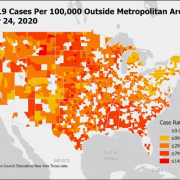Early Information on Paycheck Protection Program Round 2
Following is a summary of what we know as of December 29, 2020 regarding the second round of the Paycheck Protection Program (PPP2) approved in the coronavirus relief bill signed into law on December 27, 2020. The Small Business Administration (SBA) and Treasury Department will likely provide additional information and guidance in the new year.
PPP2 Funding
- The maximum loan amount for PPP2 is $2 million (down from $10 million in the CARES Act).
- The coronavirus relief bill allocates just over $284 billion for PPP2 loans.
PPP2 Loan Categories
- First time PPP loans for businesses who qualified under the CARES Act but did not get a loan
- Second draw PPP loans for businesses that obtained a PPP loan but need additional funding
- Additional funding for businesses that returned their first PPP loan or did not get the full amount for which they qualified
PPP2 Loan Eligibility
Eligible small businesses may include:
- Small businesses, nonprofit organizations, veterans organizations, Tribal business concerns, and small agricultural cooperatives that meet the SBA size standards
- Sole proprietors, self employed individuals or independent contractors
- New: Certain small news organizations, destination marketing organizations, housing cooperatives, and 501(c)(6) nonprofits may now also be eligible
Previous PPP recipients may apply for another loan of up to $2 million, if they:
- Have 300 or fewer employees
- Have used or will use the full amount of their first PPP loan
- Can show a 25% gross revenue decline in any 2020 quarter compared with the same quarter in 2019 (note: there are instructions for business operating by 2/15/2020 that did not exist in early 2019)
- Returned all or a part of a previous PPP loan
PPP2 will permit first-time borrowers that are:
- Nonprofit organizations, including churches
- Businesses with 500 or fewer employees that are eligible for other SBA 7(a) loans
- Sole proprietors, independent contractors, and eligible self-employed individuals.
Calculating a 25% Reduction in Revenue
Compare gross receipts (before expenses are subtracted) for any quarter in 2020 to the same quarter in 2019 to determine if revenues decreased by at least 25% (note: there are instructions for business operating by 2/15/2020 that did not exist in early 2019).
For Small PPP2 Loans (of up to $150,000)
- For loans of up to $150,000 the organization can simply certify the revenue loss in the application. Before the organization can apply for forgiveness, however, it will have to produce documentation of the revenue loss. Please look for additional guidance from SBA in the weeks to come.
- The statute creates simplified forgiveness for loans of $150,000 or less. The SBA Administrator has 24 days after the law’s enactment on December 27 to release a new one-page forgiveness application for loans of $150,000 or less — which includes loans under both the first round and the new PPP2.
PPP2 Loans and Payroll Costs
- A business may qualify for up to 2.5 times average monthly payroll costs.
- Borrowers will need to spend at least 60% of loan proceeds funding on qualified payroll expenses.
- Payroll is defined essentially the same way as in the CARES Act.
- An individual employee cannot earn in excess of $100,000 annually, as prorated for the covered period.
- Borrowers may spend up to 40% on other qualified non-payroll expenses, during the covered period. The list of eligible non-payroll expenses includes:
- Rent
- Mortgage interest
- Utilities
- Covered operations expenditure
- Covered property damage cost
- Covered supplier cost
- Covered worker protection expenditure
PPP2 Loan Forgiveness
- It appears that PPP2 loans may be entirely forgiven if spent for the proper purposes during the permitted time period.
- There are currently three PPP loan forgiveness applications (Form 3508, Form 3508EZ, and Form 3508S)
- SBA is likely to revise or provide new loan forgiveness applications for PPP2.
Other Information
Like the original PPP under the CARES Act, there is no credit check required, there is no personal guarantee, and normal SBA collateral requirements are waived.
The President signed the legislation on December 27, 2020 and the SBA Administrator has ten days to issue regulations. At this time, we expect these loans to be available in early January.
Other resources approved in the bill include:
- $20 billion in new emergency Economic Injury Disaster Loans
- Extension of pandemic unemployment benefits for the self-employed and independent contractors
- Extension of payment relief for eligible SBA loans
- $12 billion for CDFIs.





